In this post, we offer a simple Morphology Lesson Planning Template that provides a systematic approach to integrating morphology instruction into your classroom.
When you consider vocabulary instruction, probably the first thing that comes to mind is teaching specific words – ideally, lots of high-utility academic words. However, dedicated time for explicit morphology instruction is an often overlooked superhero of a well-rounded approach to teaching vocabulary.
Let’s Start with a Morphology Definition
So, what is the definition of morphology, anyway?
In a nutshell, morphology is the study of the smallest meaningful parts–morphemes–of words.
And the way these parts (morphemes) come together to create words that connect to each other (word networks) and will show up throughout written English is also a part of studying morphemes or morphology.
For example, to illustrate the definition of the word morphology, we can take a close look at the morphology of morphology. ☺️
morphology
morph – ology
So, rather than dividing the word morphology into syllables, we’ve divided it into morphemes, the smallest meaningful chunks within the word morphology.
Right away, you likely notice the familiar suffix (word ending) –ology, which means the study of something. But, the study of what?
Well, to figure that out, we consider the base of the word morph– (from Greek), which refers to the form or structure of something. In this case, the form or structure of . . . words.
Morph- (form or structure) + -ology (study of)
=
the study of form and structure of words
So, morphology is the study of the form or structure of words. Of course, studying morphology means looking at word parts–affixes, roots, bases–that show up across the English language. This means that studying morphology also makes it easier to see the relationships between words.
So, What Does Morphology Instruction Look Like?
When we provide morphology instruction, we engage students in an exploration of the meaningful parts of words in ways that can later be leveraged to unlock the meaning of the unfamiliar words they encounter. Understanding the pieces of words that make up the morphological catalog of the English language also sets students up to build words and better communicate their ideas.
In our recent book (co-authored with Katie Egan Cunningham), we describe morphology instruction as helping students become “word detectives” by teaching them how to look INSIDE words for clues to their meanings.
For instance, if students learn that the suffix -ology means the study of something, they’ll be able to use that clue to help them infer the meaning of lots of other words. For example,
musicology
mythology
climatology
toxicology
biology
zoology
criminology
That’s the power of morph-ology. But, studying morphology is more than just memorizing some word parts and their meanings. Learning the meanings of the morphological building blocks of language–and how they come together and pull apart to change the meanings of words–strengthens our skills for:
- Figuring out. Using morphology to figure out unfamiliar words increases a reader’s ability to teach themselves new words in context. This is important because there are far too many words for students to learn than we can explicitly teach! Not to mention that vocabulary knowledge (or the lack thereof) is a major impediment to comprehension.
- Connecting to word networks. Being able to connect words to larger word networks is important because understanding the relationships between words not only helps us remember the new word but also helps us use words more precisely when we speak or write. And when we read, the stronger our word connections and the larger the network is between related words–such as discouraged and discontent–the more we understand the nuances of what we read.
As you can see, morphology can play an important role in deepening students’ understanding of language while empowering them to make informed inferences about the meanings of unknown words.
The Basics of Morphology: A Few Definitions
Before you can really dig into teaching morphology, it is helpful to understand some things about it. In particular, terms like bases, affixes, and suffixes can help you understand how the various networks of English words are connected.
As you know, morphemes are the smallest meaningful chunks of language, but morphemes do come in different forms. Here are a few.
Bases – These are words that can always stand on their own, so they are called free morphemes. They don’t need to be combined with any other chunks to form a word. But, they can be added onto with prefixes and suffixes: heat, re+heat, re+heat+ing to form new words.
Greek and Latin Roots – Different from simple base words that can always stand on their own, Greek and Latin roots are word parts that have consistent meaning across words but are usually not able to stand on their own.
-
- Bound Morpheme Root – Aud – (having to do with sound) because it cannot stand alone.
- Free Morpheme Root – Act (to do something) because it can stand alone.
Affixes – These are word parts that are attached (or affixed) to roots or bases to change the meaning of a word. Affixes are bound morphemes. They need to be connected to other word parts to be meaningful. Affixes come in two forms:
-
- Prefixes – Just as the name suggests (pre- means before) are parts of words that are attached (or affixed) to the beginning of the word.
Suffixes – The word suffix is derived from Latin words meaning subordinate and fasten. Suffixes are fastened to the end of the word.
So in the word replanted, the prefix re- means again, the root plant means, well, plant, and the suffix -ed means that the replanting happened in the past.
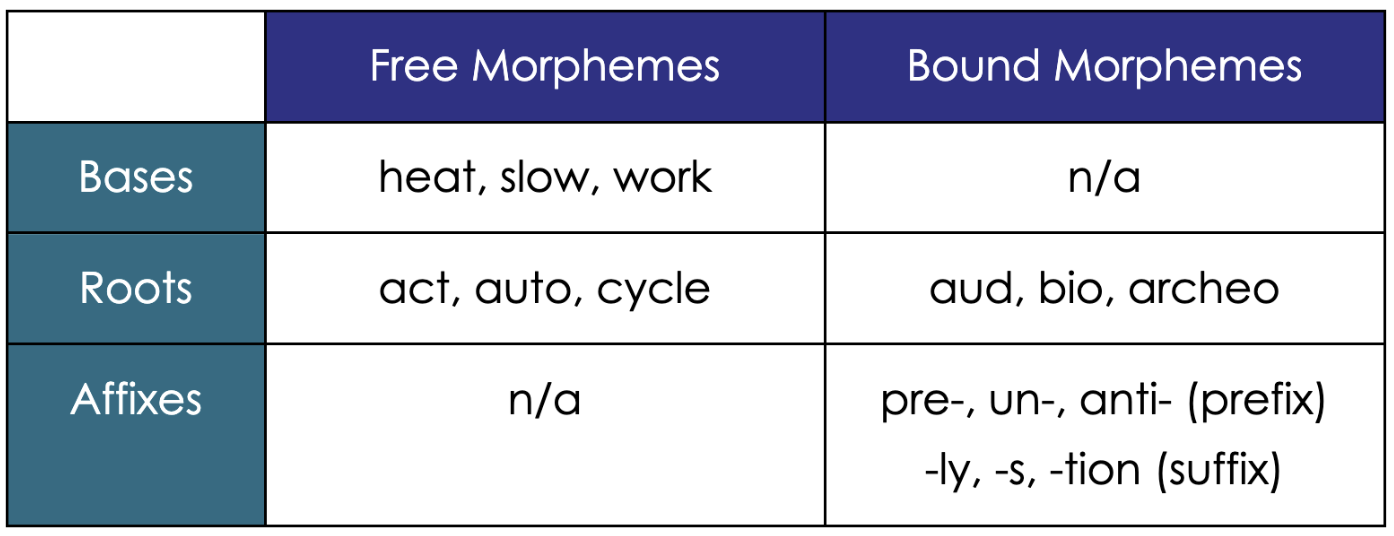
Teaching Morphology: The WHAT and the HOW
If you’re curious about how to infuse morphology lessons into your teaching toolkit, you’re certainly not alone. Leveraging the meaningful parts of words to understand new words is top of mind for a lot of literacy educators these days.
In Shifting the Balance: 6 Ways to Bring the Science of Reading into the Upper Elementary Classroom (both the book and the online class), Shift 3 is all about effective vocabulary instruction. In that Shift, we spend a lot of time on morphology as one of the ways students can learn to make informed inferences about the meanings of the unfamiliar words they encounter in their independent reading.
The WHAT of Morphology Instruction – Considering Morpheme Frequency: A Multi-Year Morphology Plan
Probably the most frequent question we get from teachers about morphology instruction is, “Which morphemes should I teach and in what order?”
Of course, there are endless possibilities for answering this question, and it’s important to note that there definitely isn’t a “right” or “wrong” answer. So, don’t let worrying over choosing the perfect set of morphemes keep you from digging into morphology instruction.
On the other hand, if you’d like to see one suggested path for morphology instruction across the grades, we have put together a sample morphology plan–a scope and sequence for morphology instruction across grades–that does just that. You can download our Multi-Year Morphology Plan here.
This plan was designed by analyzing several lists of common, high-leverage morphemes and thoughtfully considering how they might be placed across the grades. For each morpheme, we offer example words that range from simpler to more complex.
This plan does not include every morpheme, and in fact, it includes just 20 per grade. But equipped with these dozens of morphemes, children will be able to unlock the meanings of countless words.
We have organized the morphology plan into four sets of words:
- Set 1: Grades 3 and Below
- Set 2: Grades 3-4
- Set 3: Grades 4-5+
- Set 4: Other Useful Morphemes
These lists – paired with our Planning Template for Explicit Morphology Instruction – are designed to give you a simple starting place for teaching morphology. Of course, there are many other ways that morpheme instruction might be divided across the grades – this is not THE plan; this is just A plan. But we can start here as we think about the word prediction. If we think about the three morphemes in prediction (pre-, dict-, -tion), the prefix pre- is on the third row of this plan, which means that it is one of the most commonly occurring prefixes and a viable candidate for a morphology lesson.
Pretty simple, huh? Of course, you might have other reasons for teaching certain morphemes, such as introducing certain words in a content area–such as bio- in biology, biologist, biohazard, biosphere–choosing morphemes for explicit morphology instruction is usually a matter of considering the highest frequency (most useful) morphemes. But, whether you use the morpheme lists in our Multi-Year Morphology Plan or another list, once you know WHAT morpheme you want to teach–in this case, pre- —you can turn your attention to the HOW.
The How of Morphology Instruction – 5 Simple Steps for Teaching Morphology to Improve Literacy: A Morphology Lesson Template
Here’s the good news – morphology instruction doesn’t need to be fancy, time-consuming, or laborious. Following this simple, 5-step procedure, you’ll be able to keep morphology instruction simple, predictable, and engaging without having to buy anything or rob a huge chunk of instructional time from somewhere else in your schedule.
You can find this Lesson Plan for Explicit Morphology Instruction for free. This tool provides a step-by-step approach to help students explore words from the inside out, using morphemes to uncover the clues to meaning hidden within a word.
Remember the word prediction above, which we broke into its morphemes. Well, the prefix pre- is a helpful morpheme for students to learn because
- It shows up a lot in English. In fact, it is among the ten most frequently occurring prefixes in English,
- It is relatively easy to teach because it can be added to so many bases familiar to children to form new words with new meanings due to the addition of the prefix.
So, here is the five-step process from our lesson plan, using the prefix pre- as the example morpheme to illustrate the steps.
- Step 1: Identify the morpheme, its meaning, and where it shows up in words.
Sample Language: Today, we are going to experiment with the prefix -pre, which means “before.” Let’s see how pre- changes the meanings of base words.
- Step 2: Provide examples of words with pre-. Think aloud as you use the words parts to define it.
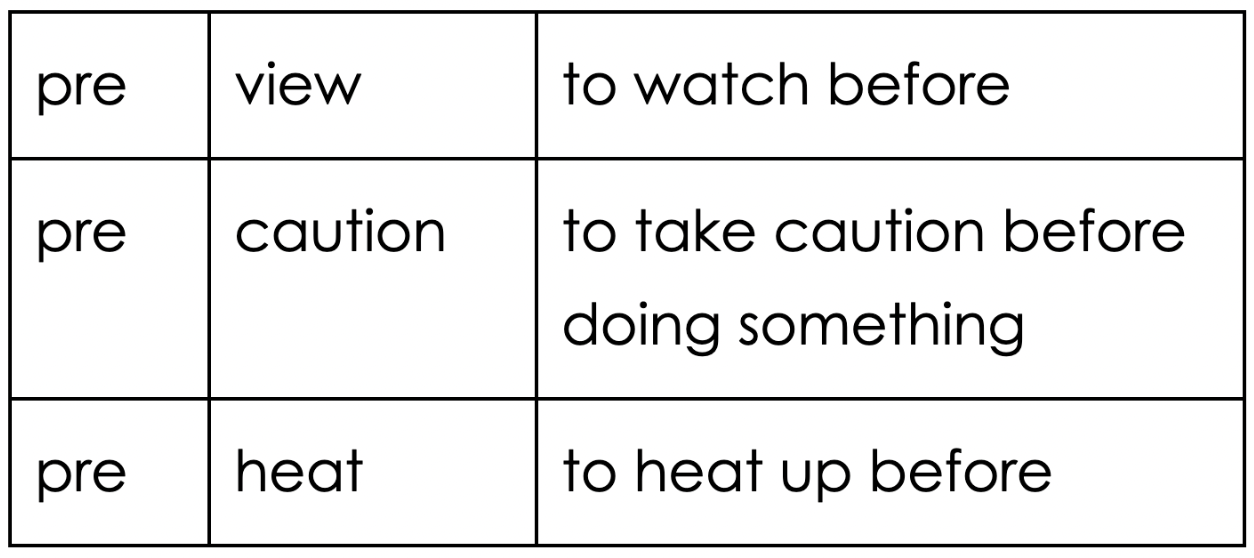
- Step 3: Offer some non-examples of the pre- in words where it doesn’t mean before.
preacher, preen, pretzel, pretty
- Step 4: Let students work in pairs or small groups to apply the new prefix to a list of bases to figure out their meanings. They can even use the new word in a sentence.
set, fix, cut, test, form, heat, term, date, caution, pay, pack, exist, judge, view
- Step 5: Ask students to fill in cloze sentences that have blanks for words from Step 2.
To make sure the movie would be okay for her little sister to watch, she decided to ________ it.
He wore safety gloves as a _______ when he worked with the lathe.
The recipe for the cake said to _________ the oven to 350 degrees.
Explicit Morphology Instruction vs. Explicit Vocabulary Instruction
You may be wondering, “So, what’s the difference between morphology instruction and other explicit vocabulary instruction?
Great question! It is easy to get confused. While they are both important components of a multi-dimensional plan for teaching vocabulary, explicit vocabulary instruction is different from explicit morphology instruction.
Explicit vocabulary instruction focuses on a specific word (i.e., prediction) and includes kid-friendly definitions, taking a close look at the orthography and phonology of the word, using the word in context, and comparing the word to other words (synonyms, antonyms, etc.). Explicit vocabulary instruction may also include exploring the morphology of the specific word (pre-, dict-, -tion), as well as other forms of the word when different morphemes are attached (predicted, predicting, predictions, etc.).
Explicit morphology lessons, on the other hand, differ from explicit word-focused vocabulary instruction because, rather than focusing on a specific word (prediction), they focus on a specific morpheme, such as the prefix pre-. Morphology lessons help students to understand the meaning and function that a particular morpheme plays when combined with other word parts so that they can use that understanding to figure out word meanings and better comprehend.
If you visit our downloads page, you might notice we offer lesson planning templates for both types of explicit instruction for developing students’ word power.
A Word of Caution About Morphology Instruction
Children will find this work empowering, especially as they discover opportunities to apply their knowledge of morphemes to unfamiliar words they encounter in the context of what they read. And it can be really exciting to see the power of this brain-friendly instruction as students apply what you have taught successfully.
However, it is also possible to get carried away. In fact, we have growing concerns about all kinds of “overdoing” going on in the field of literacy when it comes to centering explicit skills instruction these days.
So, to help you strike the right balance between ”underdoing” and “overdoing,” here are three things to keep in mind:
- Keep it short and sweet. Explicit morphology lessons shouldn’t drag on. Offer a little explanation, a little practice with the morpheme, and then a little bit of application in context. That’s enough.
- Keep it engaging. There are a lot of morphology worksheets and workbooks out there, but filling students’ time with less-than-engaging morphology practice is not the point. Equipping students with more word power tools is. So, use morphemes to play with, explore, and increase awareness of words.
- Keep it meaningful. The point of morphology instruction, of course, is to help students better understand words they encounter in reading and conversation. So, please don’t eliminate interactions with books to have more time to teach morphology! Rather, encourage students to notice the morphemes they’ve learned as they show up in the books they are reading and then to practice trying to use their morphological knowledge to comprehend.
Now you know a lot more than just the definition of morphology! By using these ideas to embrace or refresh your morphology instruction, you’ll take your students on a journey that will elevate their word power on the way to deeper comprehension.
The Lesson Planning Template we’ve shared in this blog post, in combination with the Multi-Year Morphology Plan, will help you make learning to read easier for your students. As a part of a plan multi-layered instructional model for teaching vocabulary–including both explicit and implicit approaches–morphology instruction promises to help students explore (and understand) the building blocks of meaningful language from the inside out.

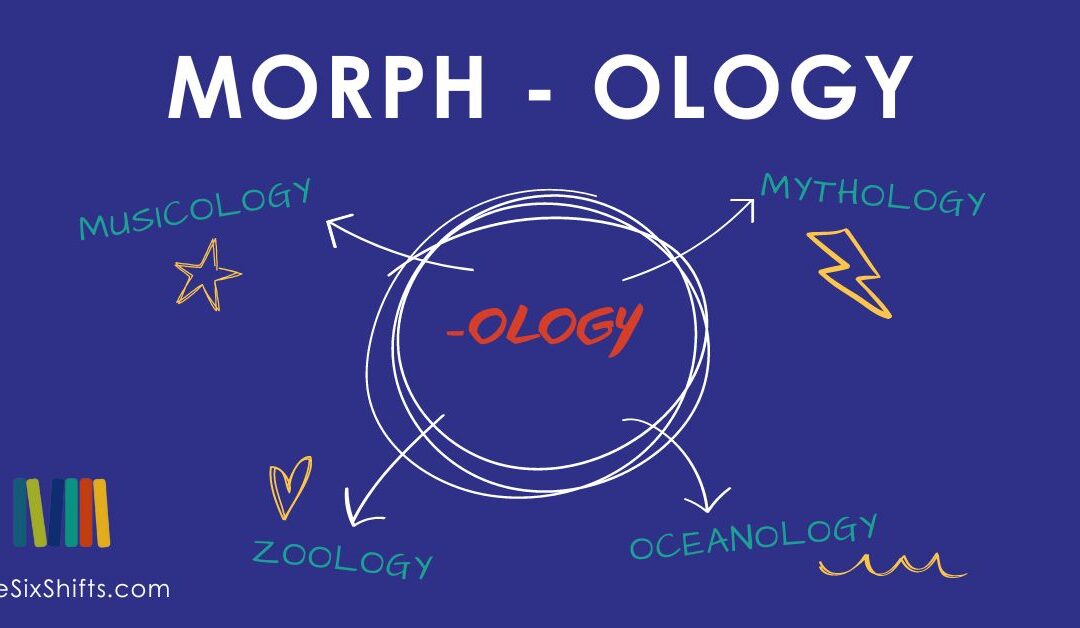
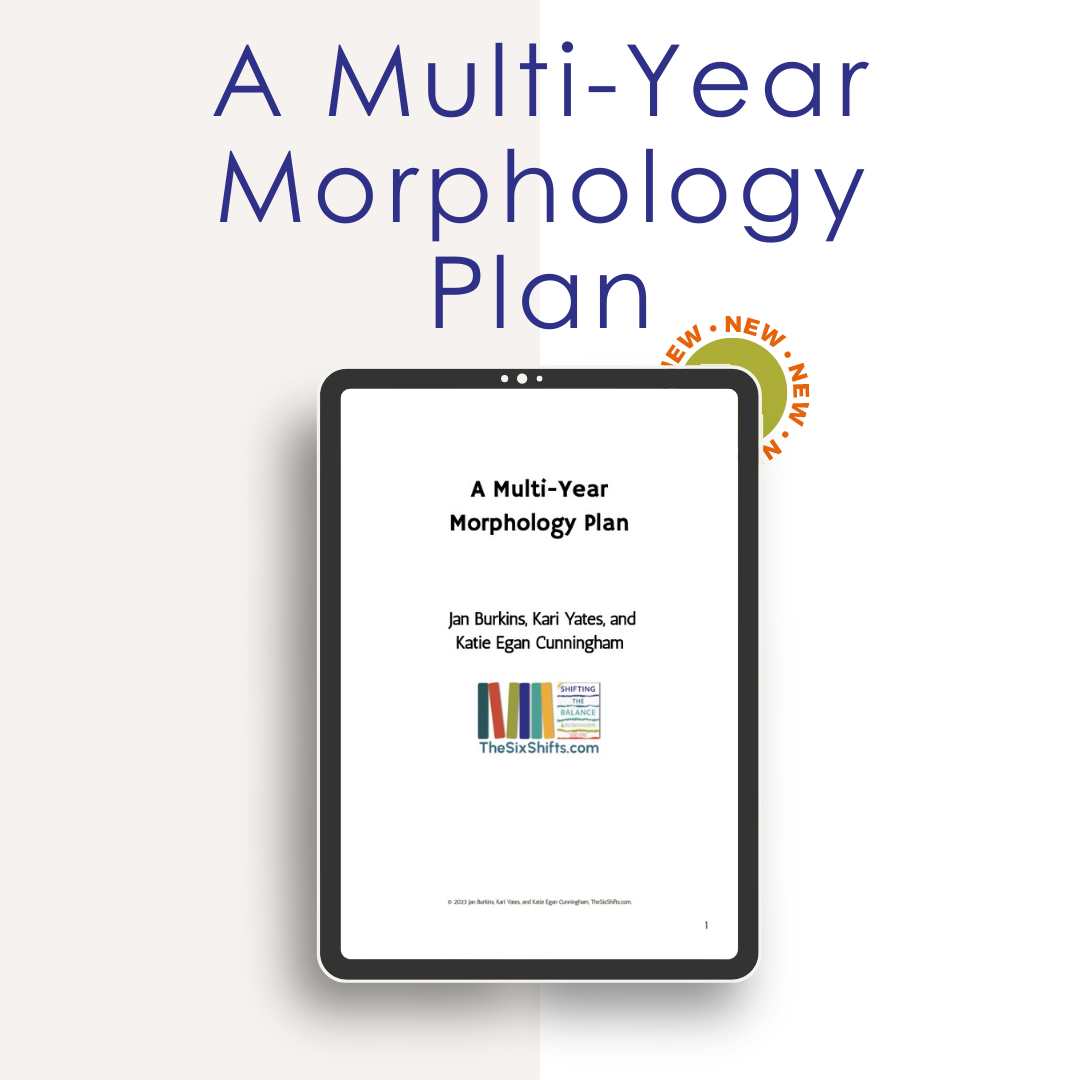
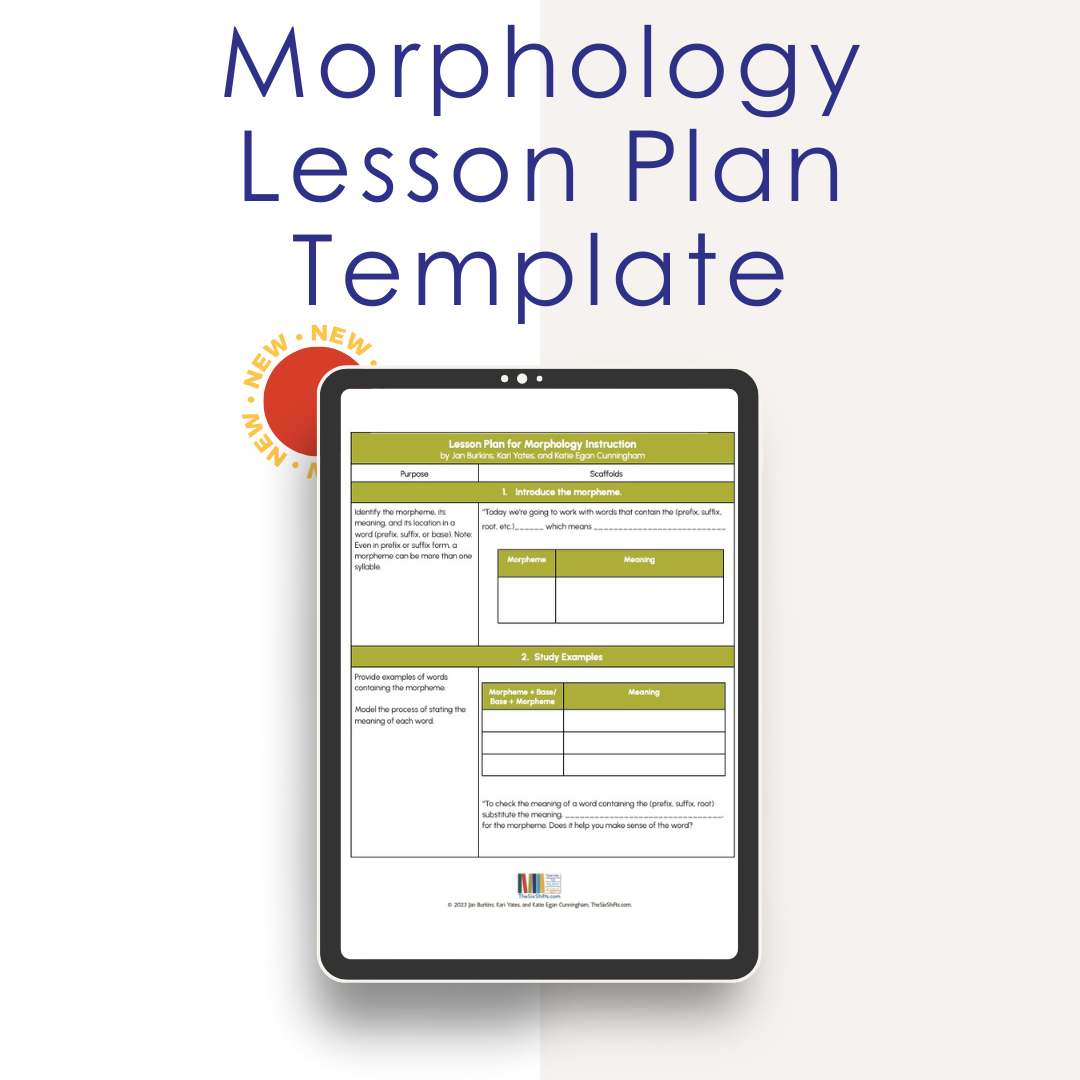


Hi Jan and Kari, do you have an editable version of this lesson template? We are using the phonics planner with great results so far and would like to start using this one for the upper grades too, so that editable version would be fantastic.
Thank you for the great suggestion! We are glad you found the editable version of the Explicit Phonics Lesson Template helpful. We will definitely add the editable version of the Morphology Lesson Template to our to-do list ❤️ As soon as we have it available we will be sure to send an email and post on our social platforms. Thanks again, Daniela!